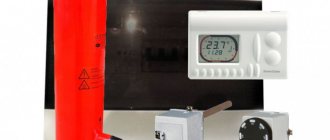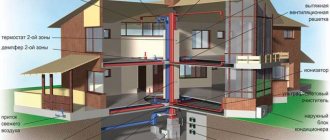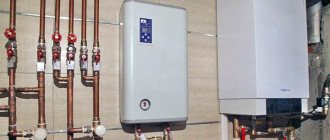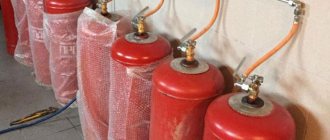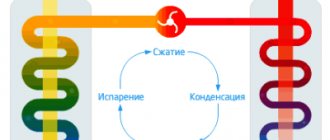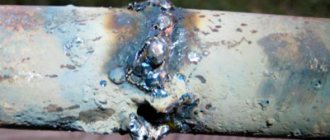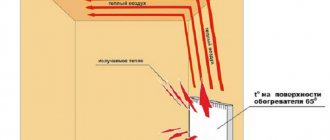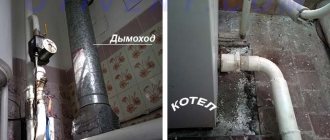Every modern inverter air conditioner can work not only for cooling, but also for heating.
It turns out that this device, in theory, can be used all year round, and not just during the summer heat.
True, there are people who still don’t believe in this, and you can easily find similar comments on the Internet.

By installing a good air conditioner as the main source of heating, you get rid of the problems with setting up and operating a gas or solid fuel boiler.

Radiators and heating pipes disappear from the rooms. There is no need to rack your brains about how best to lay out the system. Which pipes should be used to extend the supply and return lines from the boiler room in order to minimize losses.

How to adjust the temperature in the circuits. And many many others.

With an air conditioner, everything is simple and clear. Choose an installation location, pay 10-15 thousand for installation, or do it yourself, turn it on and use it.

However, do not forget that in fact, in this way you are switching to heating with electricity. All air conditioners are connected from an outlet.
And here a natural question arises: how profitable is such heating? Won't it be unprofitable compared to the same heaters or convectors?
To understand this, let's understand all the technical features and nuances.
Energy efficiency at home
Russian YouTube is full of videos about air-source heat pumps on air conditioners, and for some reason there is a clear tendency everywhere that if someone scolds them, they will definitely miss the advantages of the device and inflate the disadvantages, and vice versa.

This article will touch on both the positive and negative aspects of the issue.
Before you consider heating with air conditioning, check the insulation and energy efficiency of your home.

If it is useless, then no matter how powerful the unit you install, you will not stay warm in winter. And the type of heating has nothing to do with it.
It’s not for nothing that they say that the best heating is insulation! When everything is in order with this, you can start choosing an air conditioner.
Criterias of choice
The quality of heating the room will depend on the correct choice of air conditioner, which directly affects the comfort of the home. Before purchasing a system, its functional responsibilities should be clearly defined. If you plan to install hot water supply, you must opt for inverter units equipped with an additional hydraulic module. External air temperatures in winter have a decisive influence on the choice of air conditioner. And if in the southern regions of the country you can limit yourself to purchasing a traditional model, then in conditions of a sharply continental climate with night temperatures dropping to -30 degrees, you should buy a serious device equipped with a heat pump and a system for protecting against freezing of oil and condensate.
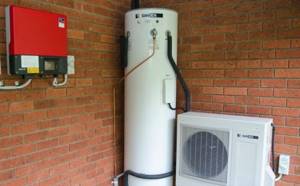
When choosing a device with a hydraulic unit, you should remember that if the device is installed outside, then it will have to be insulated for the winter. This especially applies to country houses in which accommodation during the winter period is carried out periodically or completely absent. When the hydraulic unit is located internally, the device can be connected to the “warm floor” system and radiators. Installing such equipment will certainly cost certain costs, but they will quickly pay for themselves during the life of the device.
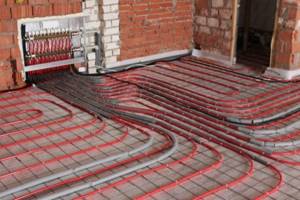
How does air conditioning work for cold and heat?
First, let's remember how a regular device works. Here is its basic technological diagram.

Any air conditioner is like a heat pump. That is, it pumps thermal energy between two heat exchangers.
The principle of operation during cooling is as follows. The entire system is filled with a special liquid - freon.

The built-in compressor in the external unit compresses it, which causes the freon to heat up. Then, passing through the condenser, it is blown by air currents and cooled, turning into a liquid state.
Since the compressor still continues to pressurize the system, the freon moves on and reaches the expansion valve or flow regulator.
Simply put, the diameter of the main tube in this place increases sharply, which means a drop in pressure occurs. Losing pressure, freon goes into a gaseous state and, according to the laws of physics, cools sharply.
In this cold state, it enters the second heat exchanger or evaporator. Moreover, its temperature here is significantly lower than the ambient temperature.

As a result, freon takes excess heat from it and continues its march, returning back to the compressor. The cycle ends and everything repeats for the second round.
The operating principle of an air conditioner is heating, which is the reverse of cooling. At the same time, in modern devices there is no need to install anything additional.

When operating for heating, the air conditioner reduces the refrigerant to a temperature lower than “outside.” For example, if freon is cooled to -30C after passing through the expansion valve, then it will quite easily take heat from the surrounding air, even if it is -15C or -25C.
The whole difference will go towards heat transfer.
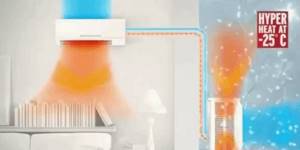
The main advantage of this scheme is that much less energy is spent on the operation of the compressor than on generating the corresponding amount of heat that the air conditioner is able to pump between two heat exchangers.
However, all conventional air conditioners, when operating on heat, have a maximum operating temperature. As a rule, it does not exceed -5C.
If you operate it at -10C and below, the air conditioner will go into the so-called zero efficiency mode.
The compressor will stop turning off altogether, will work at its maximum capacity and will eventually burn out.

To make it possible to warm up at lower temperatures, inverter models were invented.
Heating function
In winter, you can use the air conditioner if it has a heating function. On the control panel this mode is indicated by an image of the sun.
Before using this function, you must read the operating instructions for the air conditioner. After all, it indicates the minimum temperature at which this function is allowed to be used.
It is generally accepted that the maximum temperature, as a rule, does not go beyond -5°C. But there are models that can cope with frosts down to -10°C and -15°C. Most often, inverter devices can operate in such conditions and it is possible to adjust the actions of the compressor.
You should not turn on the heating function in winter, when the outside air temperature reaches the lowest point at which the air conditioner is allowed to operate. All this is due to the fact that the thermometer indicating the temperature may be off by several degrees. And even a difference of a few degrees can cause a breakdown for the split system.
Don't be alarmed if the equipment you just turned on doesn't produce warm air. The device needs to warm up, usually about 15 minutes is enough. Just make sure that the control panel does not indicate any errors.
Inverter model
If you plan to use a split system as the only heat source for the room, then you should give your preference to the inverter model. Some models of inverter air conditioners can operate at extremely low temperatures (down to -18...-30°C). What their domestic counterparts cannot boast of is that they are extremely picky about the ambient temperature and cannot be turned on in severe frosts.
Accordingly, the price for inverter devices is higher than for conventional constant-performance air conditioners.
The difference between the operation of an inverter air conditioner
What is an inverter air conditioner and how does it differ from a simple one? The traditional device works according to a simple scheme: it heats the air to a certain temperature and immediately turns off the compressor. The so-called ON-OFF system.
That is, the compressor either works or doesn’t work at certain periods of time. But in inverter models it is possible not to completely turn off the compressor, but to reduce its rated power.

Why does this happen? Due to double conversion of electric current.
Initially, the standard alternating voltage from a 220V outlet is converted to direct voltage. And only then, with the help of an inverter, the direct current is again converted into alternating current, but not with the usual frequency of 50 Hz, but with an arbitrary one.
By adjusting and changing this very frequency, you can regulate the speed of the compressor rotor, and therefore change the power during operation.

You may ask, why all these troubles with frequency and power, and what exactly do they give? And they provide several advantages:
- absence of large starting currents when turned on
- less equipment wear
- but most importantly, a lower permissible operating temperature
That is, inverter models are able to start and operate at outside temperatures of -15C and below (-25C and even -30C). The oil in the system does not stagnate, but circulates constantly.

Most inexpensive household inverters certainly do not reach such low temperatures and operate normally between -5C and -7C.
If you installed such a household model at home, and the frost outside hit -25C, is it possible to turn it on or not? There are several options here.
Firstly, it may simply not start and go into defense. But if it does start working, its efficiency will drop significantly, as will the temperature in your house.

If such a low temperature remains for several days in a row, the oil in the device will thicken.
In this case, it is not recommended to turn off the air conditioner, otherwise a subsequent cold start will kill its compressor.
During operation, for better heating of the room, all inverter models must be able to direct the air flow vertically downwards. In this case, the room will warm up much faster. There is no particular point in heating the ceiling with warm air.

Because of this feature, some advise placing the indoor unit as low as possible, at a level of 0.5 m from the floor. True, in summer such cold for the feet will be very unpleasant.
So look for a compromise.
Summer work
Any air conditioner with a cooling mode does not have a heating element. There is a valve inside the outdoor unit that helps the refrigerant circulate. The evaporator and condensate change places, and the heat exchanger of the indoor module receives the heat of the freon and cools it. The propeller forces air through the condenser and heats the air flow. The freon arrives to the outdoor unit already cold. There it takes heat from the room and releases cold.
The air conditioner does not heat the air inside, but simply circulates it. This plan is effective when the temperature outside is above zero. If the outside temperature is below 0°C, the air conditioner may not cope with the task, so it is better to purchase a more powerful model. It will warm the room even in severe frosts.
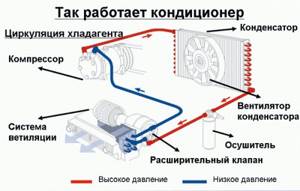
This is how an air conditioner works
COP and air conditioner efficiency
However, the ability to operate at low negative temperatures is not the main thing. What else should you focus on when choosing an inverter air conditioner, so that its operation creates a sufficient amount of heat in the house and is profitable at the same time?
The COP (Coefficient of Performance) coefficient is responsible for this - the coefficient of efficiency or conversion. It can be found in the full list of characteristics.
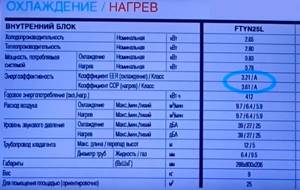
COP is the ratio of the thermal performance of an air conditioner in heating mode to its electrical power, that is, how much electricity it consumes from the outlet.
What COP value is considered good? For the best models it reaches 5 units. From 3.5 to 4.0 these are average parameters.

For example, cop=3.61 means that with a power of 1 kW, such an inverter is capable of pumping a thermal power of 3.61 kW into the room in 1 hour.

A similar parameter when working for cooling is called coefficient. EER. It shows how much thermal power is pumped out of the room in accordance with the consumed electrical power of the air conditioner.

The higher the COP, the more profitable and expensive the air conditioner. As mentioned above, a good value is COP=5.0. Having such a device, having spent one kilowatt of electric energy in 1 hour, you will drive 5 kW of heat into your room.
How profitable is this? At current prices for electricity, 1 kW of heat when heating with such an air conditioner in Moscow or the region will cost you about 1 ruble.
In some regions, costs will be one and a half times less. It seems that it is even cheaper than heating with wood, not to mention heating with other electrical appliances.

But this is where the main trick lies. The OPC parameter specified in the technical documentation was measured under some ideal conditions. Specifically, when working for heating with an ambient temperature of +7C.

As the outside temperature decreases, the COP will decrease, just as it does when the room temperature increases. If the best Japanese inverters have a COP of 5.0 at outdoor temperature t=+7C and room temperature +20C, and you want to heat up the room to +30C without changing the outdoor parameters, COP will immediately drop to 4.0-4.5.
And if it gets colder outside, this parameter will drop much more. In frosts of -25C, branded “Japs” have a COP within the range of 1.5-2.0. That is, the efficiency drops by half.
So what, you say. It’s still more profitable and 2 times cheaper than heating with oil batteries or a convector. Actually not quite like that.
Pros and cons of heating with a split system in winter
Split system air conditioners are quite simple to operate. You don’t need to have any special knowledge or skills to manage them without problems. But is it really worth heating the premises in this way? There are both advantages and disadvantages here. Pros:
- Compared to conventional convectors, split systems are much more efficient. Their efficiency is approximately 2-3 times higher than that of a typical heating device. Perhaps this is the main advantage of air conditioners that is worth considering.
- The room heats up quickly, the principle of forced ventilation works. There is no need to wait for the optimal microclimate to appear. Most average heating systems will only take a while to create a comfortable environment.
- Automation. Thanks to the presence of several modes, it is possible to exercise complete control, creating the most comfortable climate in the house.
- Split systems are multifunctional and their use is not limited to the winter period. In summer, such devices will cool the air. That is, air conditioners are beneficial at any time of the year.
- The installation process is quick and simple. In financial terms, this option will cost an order of magnitude cheaper than, for example, a gas boiler.
- Maintenance work actually consists only of cleaning the case from dust and sometimes rinsing the internal elements with a damp cloth.
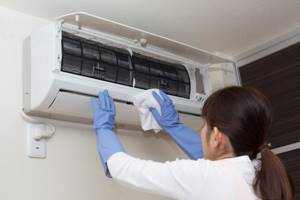
If you wish and have a minimum of knowledge, you can clean the split system yourself.
There are enough advantages. But, there are also some disadvantages. Among the most significant disadvantages of using a split system in winter, the following should be highlighted:
- As the air temperature decreases, the efficiency of the split system gradually decreases. Few models are able to properly heat a room if the temperature drops to 5-10 degrees below zero. Manufacturers are actively working on this aspect. But even today it is possible to purchase a split system that effectively operates for heating at a temperature of approximately -15°C.
- Uneven heating. For example, if the device is located under the ceiling, then you will have to forget about the warm field. Although, this drawback is also typical for the vast majority of conventional heating devices. The real breakthrough is sensors that monitor the climate in the room and can control air flow.
- Prices for split systems that operate for heating are not much lower than the cost of average convectors, and especially boilers.
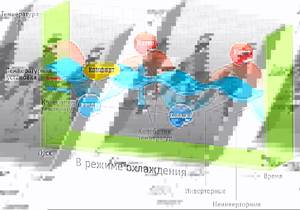
The illustration shows how unevenly the room is heated by the split system.
In a word, it is worth analyzing the pros and cons and, having certain information, make the right decision. It is worth remembering that heating with an air conditioner in cold weather is advisable only when the COP of the split system is greater than one.
It is important to note that costs vary depending on the type of air conditioner. Inverter ones are more economical, especially if you use them constantly
You can read about their differences in the article “What is the difference between an inverter air conditioner and a regular one”
When is air conditioning beneficial?
As mentioned above, manufacturers indicate “cop” under ideal conditions. They are “modestly” silent about the energy consumption for defrosting or defrosting cycles, the number and duration of which increases at -15C and below.

Add here the extra kilowatts for heating the sump and compressor crankcase. What's left in the end?
And as a result, at temperatures from -15C, even with a relatively modern inverter, you will save energy in the region of 10-20% compared to conventional heaters.
If the COP was initially low (domestic model), then you will not receive any benefit at all. It's the same as buying a 2-kilowatt heat blower and running it under the ceiling.

Therefore, look at the average annual winter temperature in your region and in the presence of prolonged cold weather, buy air conditioners with a COP efficiency rating of 4 or higher.
Only in this case will heating with air conditioners be more profitable than heating the room with direct heating devices.
To understand the effectiveness of a particular model, you need to compare their COP graphs depending on the ambient temperature.
How it all began
I bought a small two-story house of 120 sq. m. m in the center of Crimea, in a small gardening partnership. Essentially, it was just a box made of shell rock, without even a roof. I hired a team of local builders who did it completely for me, from the roof to the interior decoration.
Looking ahead, I’ll say that they were the ones who robbed me, but since I have no experience in this matter, I had to fork out the cash.
There is no gas in the village, and in order to provide electricity to the house, I had to buy poles myself and pay for the connection. All this cost 6 thousand evergreen pieces of paper.
I decided that I would heat it with coal, for which I bought a whole LAWN of anthracite in bags and lowered it into the basement. There was also a small room set aside for the boiler room. The same builders supplied me with a boiler of unknown origin and installed radiators on both floors (which I later regretted).
Comparison of air conditioners when operating for heating
Below are independent results of research and measurements of this coefficient (taking into account defrosting cycles!), which were carried out with some of the highest quality brands of air source heat pumps - Mitsubishi Electric, Panasonic, Gree, Fujitsu. To view, click on the appropriate tab.
Mitsubishi ElectricPanasonic CS-NE9MKEPanasonic CS-HE9LKEGreeMitsubishi HeavyFujitsu
Mitsubishi Electric MSZ-FH25VE + Mitsubishi Electric MUZ-FH25VEHZ

Panasonic CS-NE9MKE + CU-NE9MKE

Panasonic CS-HE9LKE + CU-HE9LKE

Gree Hansol 25-A (GWH09TB-S3DNA2D/I) + GWHT09TB-S3DNA1D/O

Mitsubishi Heavy Industries SRK25ZJX + SRK25ZJX-SA

Fujitsu ASYG09LMCB + AOYG09LMCBN

The market leader is Mitsubishi Zubadan. However, you should not believe the marketing and purchase budget models of this brand. They are distinguished from conventional splits mainly by a more powerful compressor. You are unlikely to get normal heating at -25C from them either.

The energy efficiency of real Zubadans, depending on the region of your residence and the average temperature in winter, can be calculated on a convenient online calculator on the Mitsubishi website here.
Based on the above tables, you can make your choice. Complete data on the most popular and effective brands with test reports are available via the link here (site in Finnish, use Google translator).
If COP is not initially indicated anywhere on the device, you can calculate it yourself. To do this, divide the thermal power, which is written on the device nameplate, by the consumed electrical power.

How to choose the power of the air conditioner according to the area of the room, read a separate article.

First problems
As it turned out, the builders practically did not insulate the house, and winters in my region are unpredictable. It happened that in mid-January it was +15, and sometimes it was -20. In general, I had to learn the profession of a fireman.
As it turned out, the boiler is low-power and cannot heat the required volume of water. Moreover, we had to add coal every 3-4 hours. Naturally, everything in the house cooled down overnight and the unpleasant frost invigorated me in the morning.
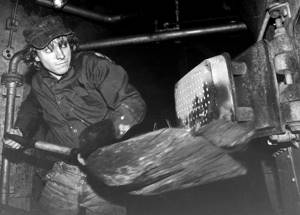
I don’t really want to provide my home with heat like that.
At first I decided to buy a new boiler and heat accumulator, and called the normal craftsmen. They said that my heating system was not designed correctly and that I would not achieve anything with this. Given the size of my basement, it was necessary to install a heated floor on the first floor. I started to think further.
Switching the air conditioner to heat
How to properly switch the air conditioner to heat? First, make sure that it is actually designed to operate in sub-zero temperatures. Check the documentation for the maximum degrees.
Switching from cooling mode to heating mode is carried out using the remote control.
In the menu or on the buttons, select the Heat mode, or the key with the sun icon.

Please note that in some remote controls, until you remove the batteries and insert them back, the “sun” icon will not appear on your screen. This is the so-called child protection so that they do not accidentally switch the air conditioner to heat in the summer.

Remember, warm air does not start flowing immediately, but after 5-10 minutes.
Correct operation of the air conditioner in winter
Careful use of a split system, wall-mounted air conditioner or mobile climate control device in accordance with the instructions is the key to its effective and long-term operation. Some companies categorically prohibit the use of air conditioning in the winter, urging owners to preserve the device. This process consists of several steps:
- freon condensation in the outdoor unit;
- starting the device in cooling mode;
- the use of a pressure manifold equipped with a service port;
- turning off the liquid supply of the main unit;
- turning off the gas supply until the atmospheric pressure is equal to the air capture pressure;
- turning off the pressure manifold.
- complete shutdown of the system power supply!
If conservation is impossible for some reason, then it is especially important not to violate the rules for operating the air conditioner in winter. Expensive models are equipped with self-diagnosis and protection systems that turn off the system automatically. At the same time, economy class brands fail quite quickly under improper operating conditions.
They continue to function until some component or structure fails
At the same time, economy class brands fail quite quickly under improper operating conditions. They continue to function until some component or structure fails.
The most common causes of air conditioner breakdowns:
- poor quality installation of equipment;
- inconsistency of the installed equipment with the customer’s goals;
- violation of operating rules;
- lack of proper maintenance.
How to ensure proper operation of any type of air conditioner in winter?
The best way is to supplement the air conditioning kit with a starter, that is, a safe engine starting device that is effective at very low outside air temperatures. In this way, it is possible to prevent those overloads at start that occur in the event of icing of the drainage pipeline.
And, of course, to ensure proper operation of the air conditioner in the autumn and winter months, you should call a professional service specialist. He will check the tightness of the system, clean the filters and give practical advice on preventing possible breakdowns.
Checking the performance of the air conditioner in winter
Any air conditioning device is equipped with a similar set of components:
- capacitor;
- compressor;
- fan;
- evaporator;
- valve.
All components are combined through narrow-section copper tubes, through which freon circulates, changing its gaseous state of aggregation to liquid, and vice versa.
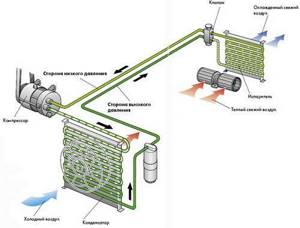
In order to check the performance of the air conditioner in winter, you need to carry out a set of preventive measures with the help of professional specialists:
- Visual inspection and diagnostics of equipment.
- Checking for compliance with the operating rules of this model.
- Cleaning the filter elements of the indoor unit.
- Cleaning the entrance and exit blinds of the indoor unit.
- Checking the temperature of dry air at the inlet of the indoor unit.
- Monitoring the condition of electrical contacts and cables.
- Checking the tightness of the pipeline system
- Monitoring the functioning of drainage.
- Control of mechanical damage to the structure.
- Cleaning the evaporator of the indoor unit.
You can also check it yourself. To do this, you should take the following steps:
- Visual inspection of the units for the absence of mechanical damage to the housing, hydraulic and electrical parts of the equipment;
- Test the operation of the device in the “heating”/cooling mode;
- Checking the operation of mechanically driven exit blinds;
- Using a vacuum cleaner, clean the fan located in the outdoor unit of the device;
- Control of dry air temperature at the inlet and outlet of the evaporator;
- Checking the average pressure in the outdoor unit;
- Checking the tightness of the connection between the indoor and outdoor units;
- Checking the tightness of the air conditioner drainage system;
- Checking the air filters of the indoor air conditioner unit.
After completing all the procedures, you should run the device in the “ventilation” mode for half an hour. Then start the device in cooling mode.
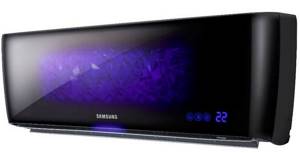
The air conditioner can work flawlessly for quite a long time. Often the deterioration of parameters occurs quite unnoticed by the owner. Only through timely inspection and prevention can malfunctions and breakdowns of expensive parts of the air conditioning device be avoided.
Features of operation in winter
In winter, the air conditioner defrosts at certain intervals. This usually happens once every 40-60 minutes.
When working for a long time at subzero temperatures, its radiator freezes over, efficiency drops, and the system begins to deal with it on its own.
Many people mistakenly believe that the external unit in this case is heated by some kind of built-in heating elements. This is wrong.
It simply switches the direction of its work. That is, hot freon from the indoor unit begins to flow into the outdoor unit. And it thaws within a few minutes.
The duration and frequency of defrost cycles depends on the degree of icing and is controlled by sensors. Although in inexpensive options this happens simply according to the programmed time.
Disadvantages of winter installation
It turns out that installing an air conditioner for the winter is profitable, convenient and quick. But there are certain nuances to such installation. They also need to be taken into account so that you don’t have to redo everything. Therefore, you first need to study all the pros and cons of installing an air conditioner in winter.
The main disadvantage is that it will not be possible to set up and check the operation of the system. It is only possible when it is working for cooling. And for this, the air temperature outside the window should be from +20˚. If it is below +15°, the compressor may fail.
If you need to install an air conditioner in winter, it is recommended to install the outdoor and indoor units and extend the connecting pipes. And check, adjustment work and start-up of the system should be planned for the warm season.
Defrosting the air conditioner and heating the pan
The water that thaws from the radiator grilles flows into the pan and ice begins to accumulate there. If it is not removed, it bends and deforms the heat exchanger tubes. Here are the clear consequences of such freezing.

Sometimes he even gets to the fan. To prevent this from happening, choose models with a heating cable built into the tray.

If you don’t have one, you’ll have to remove the lid of the device each time and use a hot kettle to pour over the frozen areas. You can’t knock anything down manually, otherwise in the cold you’ll only make it worse.

A heating cable built into the tray is an extra expense of electricity, which manufacturers are silent about. It turns on based on the temperature sensor and will generate kilowatts, even if the air conditioner is not working, but is simply plugged into the outlet.
About 2 kW can run per day.
In the tray of non-sophisticated models, you can build your own cable, bringing out the wires for connection in a separate circuit. Attach a plug to the end of the cable and turn it on through the timer socket.

In order to determine the optimal operating time, observe the air conditioner for several days and record the moments when ice forms.

Please note that if you have a new condo, you cannot drill any holes for cable fastening or additional water drainage, otherwise you will lose your warranty. Craftsmen use neodymium magnets to secure the cable.

A similar cable is used for roof heating or for heated floors outdoors.

In addition to the pallet, a couple or three turns of such wire are made around the compressor. In cold weather, this prevents the oil from thickening and makes it easier to start the device.

However, if your split system is not initially designed to operate in winter, such a home-made winter kit will not help, and even harm!
In these devices, the compressor has a slightly different winding configuration. In addition, the valves in them are designed for different condensation/boiling pressure modes.
You will also need an electronic expansion valve to keep the freon overheating on the evaporator to a minimum, and therefore work as efficiently as possible under any thermal conditions from -30C to +15C. Without all this, you will ruin your device.
One thing should not be confused with all this heating - factory winter kits for air conditioners are designed to work in winter for cooling!

When working with heat, you only need to warm up two things:
- compressor crankcase
- pallet
During the defrosting process, ice will accumulate under the air conditioner.

It would be good if it was in the form of a stalactite. He knocked it down with a crowbar and threw it aside. But most often it spreads over a large area, causing heaving of the soil and even movement of the foundation.

How to deal with this? Place a deep rubber tray under the air conditioner. All you have to do is periodically pull it out and shake it free of ice.
Try changing your air conditioner
Today, if you want to heat your apartment in winter and your average street temperature does not drop below – 25°C, then you can simply “change” your equipment to a winter set. This way you will make your unit “frost-resistant”. The specialist will modify your device with the following elements:
- Heated drainage. The drainage heater prevents the water from freezing. Removes condensation.
- Compressor crankcase. If the compressor is stopped, the heater is turned on, which warms the oil from thickening and prevents the refrigerant from leaking into the crankcase.
- Outdoor unit fan controller. It maintains a certain condensation temperature, preventing the indoor unit from freezing.
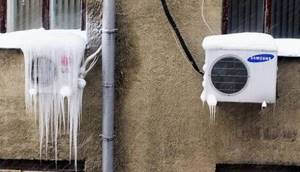
Heating with a split system
Modern systems of new units are energy efficient. Thus, the device, spending only 1 kW of electricity, delivers up to four kilowatts. “Heat with air conditioning is much more economical than electric heating,” says consumer reviews. This is because all the energy in the unit is spent moving warm air, and in electric heating devices, electrical energy is converted into heat.
If we remember Japan, where there is no oil or gas, and electricity is a luxury, using the unit as a heating device comes first.

It is difficult to imagine how you can get heat from the street, where the temperature is below zero.
Today, systems have appeared that work perfectly when it is -25°C outside the window. The operation of a split system in heat mode is based on cooling the outdoor unit and heating the indoor unit, the fan of which drives air through a hot radiator, and the now heated air is distributed throughout the room.
Thermal energy does not appear from anywhere and does not disappear into nowhere.
Winter maintenance
How should an inverter air conditioner operating for heating be maintained? Apart from ice removal, maintenance is no different from any other air conditioner.
If you do not want to breed mold and mildew, it is enough to clean its filter once every two weeks and wash the impeller twice a year after disassembling the device. All bacteria and fungi that are dangerous to health also accumulate there.

Other types of work, for example, topping up freon or inspecting the external unit, should be carried out by specialists with the appropriate equipment. You better not go there.
Optimal operating conditions
The air conditioner can be turned on for heating at temperatures above 0 degrees, and preferably above +5 degrees (in winter, spring and autumn) - this is the verdict of experts. It’s best to look at the instructions for a specific device, where the operating range will be indicated. There are models that can operate in an extended range - for example, up to -5 degrees. It is prohibited to use them in frost below this mark.
Some models can be used at fairly low temperatures, but they are rarely found on sale and are more expensive. They work in temperatures as low as -25 degrees, which is important for regions with cold winters.
How to choose a heat pump
Air conditioners for winter heating should be looked for among split systems with a heating function, taking into account first of all such a parameter as “the operating range of external temperatures in heating mode.”
Another important criterion is the maximum area of the room. Choose a split system so that the area of your room is 20% less than specified in the specifications. Area and temperature parameters significantly affect the price - the more powerful the split system, the more expensive it is. If you have additional heating, you can save money by purchasing a heat pump. For example, if you experience -25°C only a couple of times during the winter, and the rest of the time the average is -20°C, you can get by with a split system with a lower temperature of -20°C, saving a lot of money. And in more severe cold weather, switch to backup heating.
Pay attention to the energy consumption class. There are several gradations from G (lowest class) to A+++ (highest). SEER (cooling) and SCOP (heating) ratios are the ratio of a unit's cooling capacity (Q) to its power output (N). The percentage of electricity savings between high and low classes can reach 50%.

Having an inverter is ideal, as it is more economical, quieter and allows you to regulate heating faster and more accurately.
In addition to heating split systems, there are also mobile air conditioners with heating mode. However, they are ineffective for winter heating and are only suitable for heating in the off-season or for auxiliary heating. In budget models of mobile air conditioners, heating is implemented using a built-in heating element similar to fan heaters. More advanced models have a heat pump mechanism, but its efficiency is low, since heat is accumulated not from the outside air, but from the inside.
By the way, more details about choosing air conditioners are here and here.
